

Collaborative Learning. Supporting the Collaborative Learning of Practical Skills with Computer-Mediated Communications Technology. Supporting the Collaborative Learning of Practical Skills with Computer-Mediated Communications Technology Mark A.
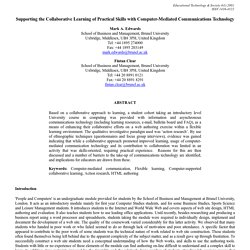
Edwards School of Business and Management, Brunel University Uxbridge, Middlesex, UB8 3PH, United Kingdom Tel: +44 1895 274000 Fax: +44 1895 203149 mark.edwards@brunel.ac.uk Fintan Clear School of Business and Management, Brunel University Uxbridge, Middlesex, UB8 3PH, United Kingdom Tel: +44 20 8891 0121 Fax: +44 20 8891 8291 fintan.clear@brunel.ac.uk Introduction 'People and Computers' is an undergraduate module provided for students by the School of Business and Management at Brunel University, London. In the British context, Light et al. (1997) explain that increasing demands on lecturer time are due to "the rapid expansion in access to university level education with diminishing funding per student", and suggests that "underfunded expansion prejudices the viability of traditional modes of teaching and learning". Flexible Learning Research Methodology Conclusions References.
When Teachers and Administrators Collaborate. Those of us in education know that systemic change requires collaboration.
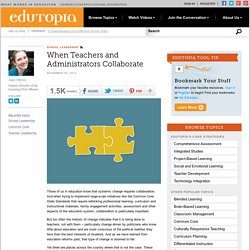
And when trying to implement large-scale initiatives like the Common Core State Standards that require rethinking professional learning, curriculum and instructional materials, family engagement activities, assessment and other aspects of the education system, collaboration is particularly important. But too often the rhetoric of change indicates that it is being done to teachers, not with them -- particularly change driven by politicians who know little about education and are more conscious of the political realities they face than the best interests of students. And as we have learned from education reforms past, that type of change is doomed to fail. Yet there are places across the country where that is not the case. Collaboration in ABC ABC has been widely praised for the collaborative relationship that exists between its teachers and administrators.
What Does It Look Like? Kevin Bacon - Fraternity Paddle. David Perdue's Charles Dickens Page - Oliver Twist Asks for More. Reading Dickens Oliver Asks for More Oliver Twist - Condensed from Chapter Two Nine-year-old Oliver is a resident in the parish workhouse where the boys are "issued three meals of thin gruel a day, with an onion twice a week, and half a roll on Sundays.
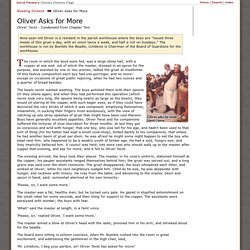
" The workhouse is run by Bumble the Beadle, Limbkins is Chairman of the Board of Guardians for the workhouse. How Rural Schools Paid for Students’ Home Internet to Transform Learning. Like many districts serving low-income populations, it was fairly easy for Piedmont City School District officials in Alabama to find funds for devices.
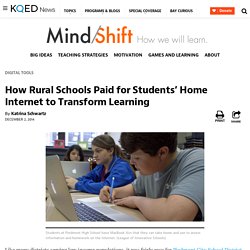
District officials wanted to leverage technology to open up opportunities for the 1,240 students in this rural community, so they started sending devices home with kids in grades 4-12 in 2009 through a program they call mPower Piedmont. However, lack of access to the Internet after school and in kids’ homes became a major obstacle to learning with those devices. At first, teachers tried to work around Internet limitations, letting students download what they’d need for work at home before they left school.
Teachers also helped students find places in the community that had free Internet, like restaurants. “It was really not fair to say this homework requires Internet access, and if you don’t have it, go to McDonald’s,” Akin said. Changing a Rural Community’s Expectations Through 24/7 Learning from Digital Promise on Vimeo. One vision of tomorrow’s college: Cheap, and you get an education, not a degree. (Illustration by Doug Chayka) Higher education — increasingly unaffordable and unattainable — is on the verge of a transformation that not only could remedy that, but could change the role college plays in our society.
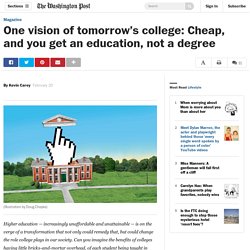
Can you imagine the benefits of colleges having little bricks-and-mortar overhead, of each student being taught in ways scientifically tailored to their individual needs, of educators, students and researchers being able to capitalize on global intelligence? In “The End of College: Creating the Future of Learning and the University of Everywhere,” Kevin Carey, director of the Education Policy Program at the New America Foundation, a public-policy think tank in Washington, lays out a provocative history of how the university system got to this point and one vision of the revolution that’s beginning because of digital innovation. Riverhead will publish the book March 3 .
An excerpt: The University of Everywhere is on the horizon. E-mail us at wpmagazine@washpost.com. What is a MOOC? What in the world is a MOOC? - Campus Overload. Posted at 02:25 PM ET, 09/24/2012 Sep 24, 2012 06:25 PM EDT TheWashingtonPost In the last few weeks, the word “MOOC” has become part of the higher education lexicon.

The cute little acronym has been thrown around by administrators in suits-only meetings, casually dropped by blogging or vlogging faculty, and explained by student newspapers. The MOOC experiment. University reflects on successes, challenges of online learning The past year-and-a-half has seen the University dive headfirst into the once-foreign frontier of online education, notably through its offering of more than a dozen massive open online courses, or MOOCs.
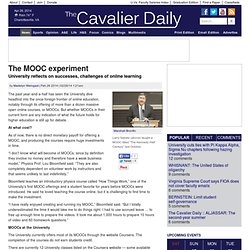
But whether MOOCs in their current form are any indication of what the future holds for higher education is still up for debate. At what cost? Coursera - Free Online Courses From Top Universities. The 4C's: Making 21st Century Education Happen.